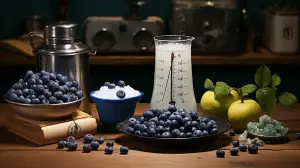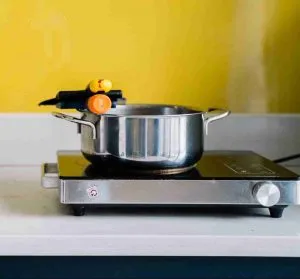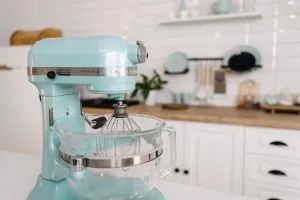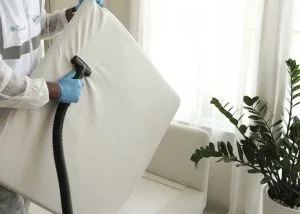Contents
ToggleKey Takeaways:
- Water stains on marble countertops can be effectively removed using a simple solution of dish soap and water. This method is gentle yet effective in restoring the marble’s original appearance.
- For more stubborn water stains, steel wool can be used to gently scrub the surface. However, it is important to use a fine-grit steel wool and apply light pressure to avoid scratching the marble.
- In cases of extra-tough stains, a baking soda poultice can be created by mixing baking soda with water to form a paste. This paste should be applied to the stain and left to sit overnight before being gently scrubbed off.
- It is essential to avoid using acidic substances, such as vinegar or lemon juice, as they can etch the marble surface and cause further damage. Stick to mild, non-acidic cleaners to prevent any unwanted reactions.
Introduction
Marble is a beautiful and luxurious material used in many homes and buildings. However, over time, water stains can develop, detracting from its elegance. To restore the pristine appearance of various surfaces, whether it’s a marble countertop or a used couch, it is crucial to understand how to remove water stains effectively. This article provides valuable insights and techniques for safely and efficiently eliminating water stains from marble surfaces.
When it comes to removing water stains from marble, it is essential to approach the task with caution. Certain cleaning agents and abrasive materials can actually worsen the problem or damage the marble surface. Therefore, it is crucial to use the right products and techniques to ensure successful stain removal without causing any harm. By following the recommended steps and utilizing specialized marble cleaning products, individuals can restore the natural beauty of their marble surfaces.
In addition to the effective methods, it is worth noting that prevention is key when it comes to water stains on marble. Investing in quality sealants and regularly sealing the marble can help to minimize the risk of future stains. By taking proactive measures and implementing proper maintenance practices, individuals can enjoy the beauty of their marble surfaces for years to come.
Understanding Water Stains on Marble Countertops

Water stains on marble countertops can be a frustrating issue to deal with. To help you understand this problem better, here are some key points to consider:
- Causes of water stains: Understanding the various causes of water stains is crucial. Factors such as hard water, spills, and improper maintenance can all contribute to the formation of these stains on marble countertops.
- Effects of water stains: Water stains can not only mar the appearance of your marble countertops but also etch the surface if left untreated. This can lead to permanent damage and the need for costly repairs or replacement.
- Prevention measures: Taking proactive steps to prevent water stains is essential. Using coasters, mats, or trivets for hot and cold items, promptly wiping up spills, and regularly sealing your marble countertops can help protect them from water stains.
- Removal techniques: Whether it’s water stains, food spills, or even difficult stains, knowing the right techniques for removal is important. Simple solutions like using baking soda or hydrogen peroxide, or more specialized marble cleaning products, can often effectively remove these stains.
- Professional assistance: In cases where the water stains are stubborn or the marble countertops require extensive restoration, it may be necessary to seek professional assistance. Marble restoration experts have the knowledge and tools to handle even the most challenging water stain removal tasks.
Navigating the labyrinth of water stains on marble countertops can be your key to saving not just time and money, but also unnecessary angst. Unraveling the mysteries of the causes, aftermath, and prevention, as well as mastering the art of removing these uninvited stains, you’ll be well on your way to ensuring your marble countertops retain their striking beauty and endure the test of time.
Remember, the battle against water stains is more about strategy than strength. Inappropriate cleaning approaches can escalate the water stain situation, turning a minor skirmish into a full-blown war. Hence, always stand by trusted sources and don’t hesitate to seek expert counsel when it comes to defending your marble countertops against water stains.
Furthermore, don’t underestimate the power of a good defense. Regularly shielding your marble countertops with a superior marble sealer enhances their resilience against water stains. A properly applied, top-tier sealer can dramatically diminish the probability of water stains gatecrashing your marble countertop’s pristine surface.
An intriguing nugget of truth: As per research featured in the Journal of Cultural Heritage, marble, in all its glorious grandeur, is actually quite vulnerable to water staining, all thanks to its porous nature. This fact underscores the importance of being armed with knowledge on managing water stains for the sake of preserving your marble’s exquisite charm.
Removing Water Stains Using Dish Soap
Should you discover the unwanted guest of water stains on your marble, fear not, as a solution is close at hand. Dish soap, a surprising yet effective ally in this battle, can offer a swift and easy path to victory. Let’s walk you through this process:
- Begin by stirring together a gentle yet potent potion consisting of a few drops of dish soap and warm water.
- Next, imbue a soft cloth or sponge with your newly prepared mixture.
- Lightly caress the blemished area with your damp cloth or sponge, taking care to avoid any overly zealous scrubbing that may offend your delicate marble.
- Patience is key. Allow your soapy solution to commune with the stain for a few minutes, softly persuading the water marks to loosen their grip.
- Rinse your cloth or sponge with clean water, then tenderly wipe away any lingering traces of your soap mixture from the marble’s surface.
- Finish your task by thoroughly drying the area with a dry cloth, ensuring no water spots dare to make an unwelcome return.
Remember, dish soap is a champion for lighter, more easily coaxed water stains. For those stubborn or deeper-set stains that refuse to be vanquished, do not hesitate to call upon the expertise of a professional.
By mastering the art of removing various types of stains, from water marks on marble to pencil marks on a wall, you’ll be well on your way to maintaining the pristine appearance of your home surfaces. An easy, affordable, and satisfying solution, this approach lets you relish in the satisfaction of restoring the radiant glory of your marble.
Using Steel Wool for Stubborn Water Stains
When water stains display an unnerving persistence on your marble surfaces, it’s time to bring in a stronger ally. Enter steel wool, your go-to combatant for tackling these stubborn intruders. Let’s map out this journey to restoration:
- Firstly, tenderly moisten your steel wool pad, making sure it is not dripping with water.
- With the finesse of a craftsman, softly rub the stained area with your damp steel wool pad, tracing circles as if you were sketching a masterpiece.
- Let your touch be firm but respectful, applying just enough pressure to persuade the water stains to yield, without causing undue harm to the marble beneath.
- Once the battle is won, rinse the area with a generous splash of clean water, washing away any remnants of your skirmish with the steel wool.
- The final step is drying the marble surface completely, ensuring no future water spots plan an unexpected coup.
An added touch of wisdom: to safeguard the integrity of your marble, always test this technique on a less conspicuous area before daring to tread on larger, more prominent sections.
And a word to the wise: Always wear your protective gloves when wielding steel wool. Safety is key, not just for you, but to guarantee the continued splendor of your marble surfaces.
Baking Soda Poultice for Extra-Tough Stains
At times, marble encounters a formidable adversary in the form of stubborn stains. Fear not, for there’s a champion in our midst – a baking soda poultice. This powerful knight in shining armor effortlessly combats water stains and other challenging discolorations. Let’s chart the path to this epic victory:
- Crafting the Poultice: Enter the laboratory of your kitchen and mix baking soda with water to form a paste with the consistency of thick frosting. Be an alchemist, adjusting the formula as needed until you’ve created your magic potion.
- Application – The First Battle: Arm yourself with a spatula or plastic putty knife, slathering the baking soda poultice generously over the contested territory of the stain. Ensure your white knight covers the entire battlefield, standing about a quarter-inch tall.
- Cover and Await Reinforcements: Enhance the effectiveness of your poultice by encasing it in plastic wrap or a wax paper shield. This preserves the moisture and intensifies the poultice’s power. Then comes the longest part of any battle – the waiting. Give your poultice 24 to 48 hours to lay siege, depending on the strength of the stain’s fortification.
- The Final Victory: When the time is right, remove the battle-hardened poultice with a damp cloth or sponge. Tenderly wipe away the remnants of the battle, ensuring the beauty of the marble surface underneath remains unscathed. Rinse with water to celebrate your victory.
It’s important to remember that even the best of us need a practice run. Always test your baking soda poultice on a small, hidden area before sending it to wage war on prominent stains. This way, you’re certain of no unintended collateral damage to your marble.
Now, lend me your ears for a tale that pays tribute to the baking soda poultice.
Once upon a time, a homeowner named Jane bore witness to a disaster. A carafe of red wine slipped from her hand during a dinner party, staining her pristine marble countertop. Distraught by this blemish, she sought the aid of our champion, the baking soda poultice. Steadfastly adhering to the steps outlined above, she applied the poultice, shielded it, and awaited victory. Two days later, she lifted the cover to reveal a triumph – the red wine stain had been vanquished. Jane’s countertop, restored to its former glory, dazzled both her and her guests. A testament to the prowess of the baking soda poultice.
In the realm of stain removal, the baking soda poultice stands tall. Its reliability and efficiency are unrivaled. By following these steps, you too can be victorious in your battles against stubborn stains, reclaiming the natural beauty of your marble.
Caution Against Acidic Substances
Marble, with its timeless elegance, often comes with a gentle plea for careful maintenance. A word to the wise – it harbors an unseen vulnerability to acidic substances, which can potentially scar its beauty, often irreparably.
Imagine, if you will, a table to visualize this acid-marble dynamic more clearly:
| Acidic Substance | Effect on Marble |
|---|---|
| Lemon juice | Etching and dulling |
| Vinegar | Corrosion and discoloration |
| Tomato sauce | Staining and pitting |
| Ammonia-based cleaners | Erosion and loss of shine |
This chart only scratches the surface. The world of acidic substances that could blemish your marble is vast and varied. The key is to tread lightly and always be vigilant to prevent contact between marble and these potentially harmful substances.
An important reminder to add to your marble care manual: Acidic substances play the long game. The longer they linger, the more damage they do. Swiftly and efficiently clean any accidental spills or splashes to minimize their impact.
Remember, being marble’s guardian means being armed with knowledge and caution against acidic substances. By understanding and respecting its delicate nature, we can ensure the enduring beauty of our marble surfaces for years to come.
Conclusion
Water stains on marble – a predicament that might seem daunting, but with the right tools and techniques, the solution is well within reach. One proven method is the ingenious use of a humble household staple – baking soda. When transformed into a paste with water, and gently massaged onto the stain, it can effectively lift discoloration. A rinse with water, and voila – your marble starts regaining its splendor.
For the stubborn stains that refuse to bow down to baking soda, a poultice comes to the rescue. A blend of hydrogen peroxide and a powdered substance, like talc or chalk, when left overnight, can work wonders. It acts like a magnet, drawing out both moisture and stain from the marble.
Now, to keep those unsightly water stains at bay, regular sealing of marble surfaces plays a crucial role. It’s an ounce of prevention that helps maintain the pristine appeal of marble.
Here’s a word to the wise before you embark on your marble-cleaning mission: Always perform a patch test of your chosen cleaning method on a hidden corner. It’s your insurance against any unwanted surprises on larger, more visible sections of the surface.
These effective strategies can help you triumph over water stains on marble, letting you unveil its hidden beauty once again.
A Pro’s Wisdom: Sidestep the siren call of acidic or abrasive cleaning agents when dealing with marble. They might promise a quick fix but often leave behind a trail of damage on the marble surface. Stick to marble-friendly options, and your countertop will thank you for it.
Five Facts About How To Remove Water Stains From Marble:
- ✅ Water stains on marble countertops can appear as dull spots that break up the glossy surface. (Source: Team Research)
- ✅ Marble can also be etched by acidic liquids, which results in a dull mark that resembles a hard water stain. (Source: Team Research)
- ✅ Mild dish soap and a damp cloth can be used to remove light water stains from marble surfaces. (Source: Team Research)
- ✅ Steel wool can be used to gently rub water stains on marble countertops, effectively removing the marks without causing scratches. (Source: Team Research)
- ✅ For tough water stains, a baking soda poultice can be applied and left overnight to break down the stains before wiping them away. (Source: Team Research)
FAQs
How do I remove water stains from my natural stone countertop?
To remove water stains from your natural stone countertop, such as marble, you can use mild dish soap and warm water. Mix a few drops of liquid soap with warm water in a spray bottle, spritz it on the water stain, and wipe it in a circular motion with a damp cloth. You can also use a soft bristle brush for light scouring. Rinse the spot with fresh water and thoroughly dry it to prevent soap scum or more water spots.
What do water stains look like on a marble countertop?
Water stains on a marble countertop appear as dull spots that break up the glossy surface. They can be caused by mineral deposits left behind after water evaporates, resulting in clear marks that resemble hard water stains. It’s important to differentiate between water stains and etching, as etching occurs when acidic liquids sit on the marble surface and cause the surface layer to wear away, resulting in dull marks.
Can water stains be removed from marble surfaces?
Yes, water stains can be removed from marble surfaces. You don’t need to polish the marble to restore it when dealing with hard water stains. Instead, a mild cleaner, such as dish soap and water, can help break down the water stain without causing damage to the marble surface.
Is dish soap an effective cleaner for removing water stains on marble?
Yes, dish soap can be an effective cleaner for removing water stains on marble. For light staining, a mixture of warm water and a few drops of dish soap can be applied to the stain using a cloth or spray bottle. Gently agitate the mixture in a circular motion and rinse with fresh water. Be sure to dry the surface immediately to prevent soap scum or additional water spots.
Can steel wool be used to remove water stains from marble?
Yes, steel wool can be effective in removing water stains from marble surfaces. However, it is important to use super-fine steel wool or steel wool soap pads to avoid causing scratches or damage to the marble. After applying a mild dish soap and water mixture, gently rub the water stain with the steel wool until the mark is gone. Rinse with water and thoroughly dry the surface.
How can baking soda help remove tough water stains from marble?
Baking soda can be used as a poultice to remove tough water stains from marble. Create a thick paste by mixing baking soda and water, then apply it to the water stain, ensuring full coverage. Cover the area with plastic wrap and let it sit overnight or for up to 24 hours. Once dry, remove the plastic wrap and use a plastic scraper to loosen the baking soda. Wipe the area clean with a damp, soft towel.
Additional Reading
To enhance your understanding of how to deal with various types of stains, you may find the following articles helpful:
- How to Remove Turmeric Stains: Turmeric can leave stubborn yellow stains. This article provides a step-by-step guide on how to effectively remove them.
- How to Get Purple Shampoo Out of Hair: If purple shampoo has stained your hair, this guide offers solutions to restore your hair’s natural color.
- How to Get Poop Stains Out of Underwear: This article presents effective methods to get rid of tough poop stains from underwear.
- How to Get Food Coloring off Skin: This piece gives insights on how to remove food coloring from your skin safely.
- Removing Wood Stain from Concrete: If wood stain has somehow ended up on your concrete, find out how to clean it up in this post.
- How to Clean Drywall Dust: This article offers valuable tips on how to deal with drywall dust, which can be difficult to clean up if not handled correctly.























































